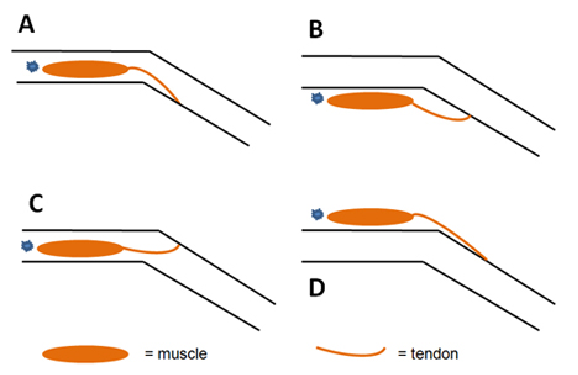The figure below represents a joint in the hind leg of a grasshopper. The exoskeleton of the leg is indicated by the two pairs of parallel black lines. A muscle that moves this leg is fixed to the skeleton at the end marked with a blue star. When the muscle contracts, it will pull on the tendon at its opposite end. Which configuration shows the most likely arrangement of the exoskeleton and a muscle that increases the flexion of this leg?

A. A
B. B
C. C
D. D
Clarify Question
· What is the key concept addressed by the question?
· What type of thinking is required?
Gather Content
· What do you know about the orientation of a muscle in a joint? What other information is related to the question?
Choose Answer
· Given what you now know, what information is most likely to produce the correct answer?
Reflect on Process
· Did your problem-solving process lead you to the correct answer? If not, where did the process break down or lead you astray? How can you revise your approach to produce a more desirable result?
C. C
Clarify Question
· What is the key concept addressed by the question?
o The question asks about the orientation of a muscle in a joint.
· What type of thinking is required?
o You are being asked to analyze diagrams of a joint to predict how the muscles will be oriented.
Gather Content
· What do you know about the orientation of a muscle in a joint? What other information is related to the question?
o Exoskeletal muscles produce movement of the exoskeleton when they contract. In the diagram, the exoskeleton of the leg is indicated by the two pairs of parallel black lines. The muscle that moves this leg is fixed to the skeleton at the end marked with a blue star with tendon at its opposite end. For the leg to flex or bend when the muscle contracts it will pull the two ends of the exoskeleton closer to each other as shown in A and B. The muscle is inside of the grasshopper’s exoskeleton as shown in A and C, just like your muscles are under your skin.
Choose Answer
· Given what you now know, what information is most likely to produce the correct answer?
o The best answer is C, because it has the muscles inside of the exoskeleton and the connections to the joint are oriented so that when the muscle contracts the two ends of the exoskeleton will be pulled towards each other causing the joint to flex.
Reflect on Process
· Did your problem-solving process lead you to the correct answer? If not, where did the process break down or lead you astray? How can you revise your approach to produce a more desirable result?
o This question asked you to analyze diagrams of a joint to predict how the muscles will be oriented. If you got the correct answer, great job! If you got an incorrect answer, where did the process break down? Did you think that the muscles could be outside of the exoskeleton? Did you think that the muscles would extend to push the joint causing it to flex?
You might also like to view...
The pigment responsible for photoperiodism is
a. chlorophyll. b. xanthophyll. c. anthocyanin. d. phytochrome. e. phytoerythrin.
What biome has the highest rate of primary productivity?
a. savanna b. tundra c. algal beds and reefs d. temperate grassland e. tropical rain forest
Plant hormones are small organic molecules produced by the plants themselves.
a. true b. false
The movement of water and a dissolved substance from an area of high pressure to an area of low pressure is called:
A) filtration. B) active transport. C) facilitated diffusion. D) passive transport diffusion.